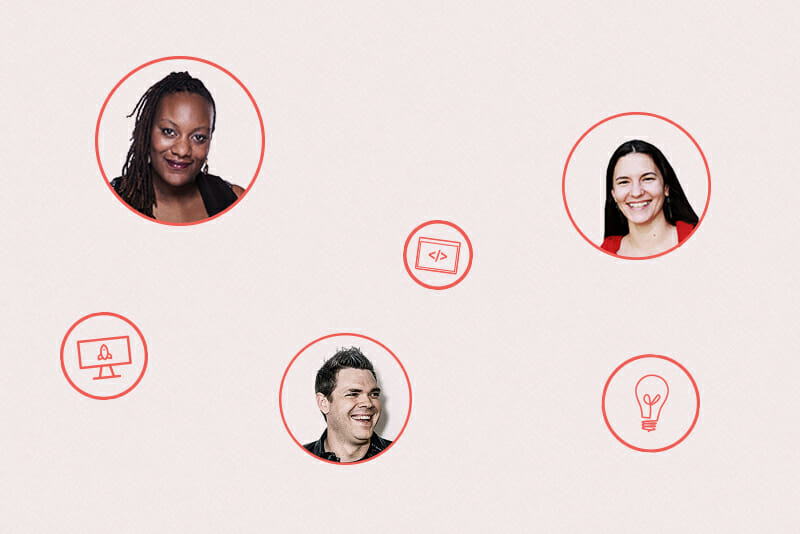The 7 Things the Most Successful Web Devs and Designers Have in Common
The very best designers and developers share these 7 similarities in mindset and habits when navigating their careers in tech.


Becoming a great designer or developer isn’t just about learning new tools—how you go above and beyond matters just as much when it comes to crafting a truly stellar career. Sure, you can learn the technical skills you need to land a job, but that’s not enough to rise to the top of your field. Going from solidly qualified to wildly innovative is a different story.
Confession time: I was never a particularly illustrious developer or designer. I’ve designed and developed projects I’m proud of, but I definitely didn’t rank up there with the “greats”—the ones speaking at conferences, booking the biggest clients, and turning out endlessly revolutionary projects. (Luckily, I translated those tech skills into my ideal job as a remote tech editor). But noteworthy web pro or not, I’ve kept an eye on what the best designers and developers are up to. They have a few things in common—from mindsets and approaches to best practices and creative drive.
They have a hacker mindset, and aren’t afraid to screw up.
A hacker mindset doesn’t mean spending weekends breaking into secure servers or dumping passwords. (Don’t do that.) Instead, it’s the drive to understand the inner workings of how things function and to upend assumptions. Hackers experiment and even break things, because sometimes screwing up can be the best way to find the solution you’d never have thought up by doing things the standard way.
Marina Gorbis, executive director of The Institute for the Future in Palo Alto, CA argues in the Harvard Business Review that the hacker mindset is what really powers Silicon Valley, and how we could all learn a thing from that approach:
“If there is one thing people in general here have learned from technologists, it is that things are hack-able — that the way we’ve designed various systems is not pre-ordained or immutable. We can tinker, re-design, and play with them.”
This think-outside-the-box mentality is vital to every great developer or designer’s career. So next time you have an idea that seems out of left field, follow it. Just set up a control so if everything explodes, you can revert back to what works without too much panic.
They stay on top of innovations and trends.
The tech industry rarely stands still, and designers and developers risk falling behind unless they’re lifelong learners who make an effort to stay up-to-date. In fact, UK-based web designer Sarah Parmenter told The Great Discontent that “[t]he moment you feel like you’ve learned everything—that’s a dangerous place to be.”
Keeping your knowledge fresh isn’t rocket science, and you can easily build some maintenance into your daily routine. Find the combination of reading newsletters, blogs and books; taking classes and workshops; or attending conferences and meetups that best allow you to absorb as much information as you can about the industry.
They network, network, and then network some more.
If you follow standouts in the web world on social media, you’ll see that they’re all having conversations with one another—sharing work, looking for recommendations, or posting job openings. It’s a party with the added benefit of resources, professional opportunities, and project inspiration.
It might look like random chatting or thought dumps, but it’s so much more: they’re networking—and you should join them. Networking can give you a way into job openings without having to endlessly search job boards, alert you to surprising new projects and startups, and give you a community to tap into when you get stuck.
Following other developers on social media, meeting up with them at conferences (or your local coworking space), and generally getting to know them is the first step towards networking like an all-star developer. (Hate networking? Check out our 27 tips for making networking less painful.)
Feeling anxious about joining in? Deep breath. Noah Stokes—a San Francisco-based front end developer—had some calming words in an interview with The Great Discontent.
“Our community…is full of the warmest, most inviting, and kindest group of folks that you’ll ever meet and I’m proud to be a part of it. I would encourage anybody to shoot an email to their design hero and if they’re not a jerk, they’ll probably respond to you. It’s just that easy to do. There’s not a lot of ego out there. It’s a cool community to be a part of.”
They don’t hoard their knowledge.
Simply establishing a network isn’t enough: It’s what you do with it. Sharing knowledge freely with other designers and developers is key to advancing not only your own career and standing within the industry, but also advancing the industry itself.
This contributor mentality has been around since the early days of web standards crystallizing in the design world, Dan Cedarholm, a designer and author from Salem, MA, told The Great Discontent: “There was so much knowledge sharing going on and people were building on each other’s work. We helped each other out. I didn’t think of myself individually as contributing all this stuff; it was more about helping the greater cause of web standards and proving a point of how things could be done better moving forward.”
Wondering what this looks like? Take someone like Jeffrey Zeldman, for example, who not only founded a successful web design agency Happy Cog, but also started A List Apart—one of the most influential web design and dev blogs on the internet , a publishing company called A Book Apart, and a major tech conference, aptly called An Event Apart. Talk about giving back to the industry. On a smaller scale, you might consider blogging or even teaching workshops about your expertise.
Being a good citizen of the tech community doesn’t just elevate the industry—it’s an investment with considerable personal return. Over at A List Apart, web developer and co-founder of the CMS Perch Rachel Andrew wrote: “One thing I know for sure is that the more generous I am with my time and my knowledge, the more good fortune seems to come my way. This isn’t due to any mysterious karma at play, but simply that people talk to one another.” If people are talking about you, make sure they’re talking you—and your contributions—up.
They avoid tunnel vision.
Belgium-based designer and front end developer Veerle Pieters told Creative Market: “I’ll never take on projects that only need CSS & HTML coding work. I do love variation, but I have no problem to do pure illustration work for months in a row. Most projects are web-related and involve some illustration work, which has the perfect creative balance to me.” Pieters’ broad skillset—design, illustration, and coding—makes her a prime candidate for wide-reaching and varied projects. It’s the ultimate flexibility.
So while the best developers are fluent in the programming languages they specialize in and top designers are experts on best practices inside and out for both user interface design and user experience design, both also understand the other elements that get a project off the ground. Developers understand UI and UX design, even if actually creating a design might be outside their wheelhouse. The best designers understand how programming languages work, even if actually writing the code isn’t something they’re comfortable with.
Expanding your knowledge beyond your area of expertise not only makes you better at your job but also lets you work more easily with those whose skillset differs from yours. And, you’ll be able to freely move around to different types of projects, keeping your career anything but boring.
They’re passionate about creating.
Loving what you do is a big step toward becoming great—and for the best web pros, doing isn’t limited to their 9-5 jobs. The creative mindset touches everything they do, even after they head out for the day.
When they’re off the clock, industry leaders are often creating and contributing to side projects that let them further build their skills and practice their craft—even if the projects don’t seem directly related to their day jobs. For example, Elliot Jay Stocks, the UK-based creative director for Adobe Typekit, told The Great Discontent:
“I’m creatively satisfied with something I’ve just created, however, I’m not creatively satisfied in general. I want to do so much; I feel bothered when I’m not creating something. I have side projects that I can do outside of my day job, and I make music so that I can do something outside of design. I jump between different mediums because I would go absolutely crazy if I was stuck inside the boundaries of one.”
If you’re creative enough to be a web developer or designer, you likely have other artistic strengths—and it’s worth pursuing them.
They focus on the end user.
At minimum, a developer or designer will create a website or app according to the specs given to them. For some, a project that meets specs is a job well done. But true success means going way beyond the specs and seeing your work through the eyes of the user.
On Lyft’s blog, software engineer Sean Bolton argues that you can’t simply tack on the user to the end of the project, but instead have to filter every choice through the user’s experience from Day 1:
“Because we had a better end-to-end picture in mind, we could build for the people actually using the tool and save work down the road needing to add or change features we didn’t know about. Beyond that, there is something inherently gratifying in knowing you did something to make life a little easier for the people who will be using what you made.”
So if you’re handed bad specs—if they make the user’s life more difficult, if they’re deceptive, if they complicate things needlessly—follow Bolton’s lead and make a change. Advocate for end users, even if that sometimes means going up against your employer’s or client’s requests.





